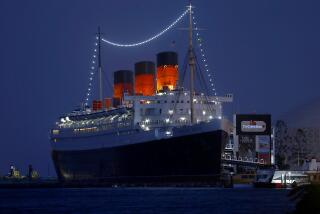‘Famine Ship’ to Set Sail for New World
- Share via
DUBLIN, Ireland — Rarely has a ship been bailed out so often before leaving port. Now, after three years and many millions, the Jeanie Johnston is finally ready to set sail to the New World this weekend.
Jeanie, a painstakingly crafted oak-and-pine replica of a 19th-century “famine ship,” was dreamed up a decade ago as a living monument to Ireland’s greatest disaster, the potato famine of 1845-52, when an estimated 1 million died and 2 million emigrated.
Instead, the Jeanie became a byword for disaster. Supposed to tour ports in the eastern United States and Canada in 2000, the vessel spent the last three years moored to a dock in County Kerry, part of the time impounded for unpaid debts.
Although the ship’s Quebec-built namesake claimed never to have lost one of its 2,500 passengers during more than a dozen profitable crossings from 1848 to 1855, the modern Jeanie has destroyed reputations and cost about $17 million -- about three times the original estimate.
But against the odds, the ship was saved when the Kerry Group, Ireland’s food-processing giant, offered investment and judges approved a bankruptcy deal. That cleared the way for Jeanie to complete sea trials and head out across the Atlantic.
“It’s definitely going. Nothing but the weather can stop us now,” said Denis Reen, chief executive of the Jeanie Johnston Co.
“It was definitely a bit of a mess, but happily the mess is behind us now, and we have a superb vessel and a happy crew,” said Reen, 61. “There are people haunted by the whole thing. It has been traumatic to see the project almost disintegrate.”
The ship’s enthusiasts predict that, with a youthful crew featuring Irish Catholics and British Protestants from Northern Ireland, the Jeanie Johnson will be a hit when it tours U.S. and Canadian cities from April to October.
Niall O’Dowd, publisher of the Irish Voice newspaper in New York, predicted that it “will become the greatest Irish American tourist attraction ever built.”
“You simply cannot board this ship without the ghosts of your past and ancestors becoming vividly alive,” he wrote after sailing aboard the Jeanie from Dublin and Belfast last month.
“We should be grateful it was built. Compared to green beer, tooraloora songs and 40 shades of green, it is as authentic a vision of old Ireland as exists,” O’Dowd added.
The 123-foot-long ship, boasting three masts and a facade of oak and pine, is not an exact reproduction. Indeed, that was part of the problem -- modern maritime law decreed that it couldn’t be. In came a steel frame, engines, desalination units, sewage treatment, even air conditioners.
The original Jeanie was luxurious by famine standards, with a fare considered prohibitively expensive at 3 shillings and 10 pence, and its own doctor. Most vessels ferrying refugees across the Atlantic in the 19th century had such poor sanitation, water and food that they were known as “coffin ships” because so many people died during the crossing.
Today’s passengers -- whose tickets cost between $2,700 and $11,000 -- are in the lap of luxury. There will be a maximum of 29 passengers, compared to 254 on the original ship. And whereas yesteryear’s passengers had to bring and cook their own food, using a single oven on the top deck, today’s will run no risk of scurvy with their own on-board chef.
“They won’t get too fat because they’ll be learning to sail, and that takes muscle, but they won’t starve either,” Reen said.
Reen is keeping the ship’s movements flexible. The first confirmed ports of call are West Palm Beach, Fla., about April 17, followed by Jacksonville, Fla., and Savannah, Ga., with about 20 more stops to follow.
Key targets are Philadelphia in June, New York around the Fourth of July, Boston later that month, then on to Quebec and back to Ireland.
More to Read
Sign up for The Wild
We’ll help you find the best places to hike, bike and run, as well as the perfect silent spots for meditation and yoga.
You may occasionally receive promotional content from the Los Angeles Times.






